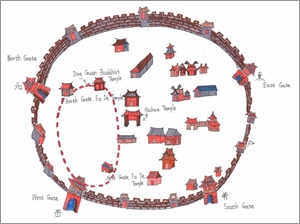Xiaoxi Then
Where was Xiaoxi? And why the name?
Since the founding of Changhua Town under the Qing Dynastic rule there had always been four gates built in the walls surrounding the town: the east gate (Le-gen Gate), the west gate (Ching-feng Gate), the south gate (Shuan-ping Gate), and the north gate (Gong-chen Gate). Xiaoxi just so happened to be located close to an important traffic route approximately in between the north and west gate (see the picture on the left or refer to map![]() and
and![]() ), and because these were the two most frequently accessed gates out of the four, residents here began referring to themselves as "Xiaoxi folks" (meaning literally people close to the west), and so originally the area to which Xiaoxi referred covered a much larger area than a mere street.
), and because these were the two most frequently accessed gates out of the four, residents here began referring to themselves as "Xiaoxi folks" (meaning literally people close to the west), and so originally the area to which Xiaoxi referred covered a much larger area than a mere street.
During the Japanese Occupation, Changhua Eki (now Changhua Train Station) was founded, and because of its importance as point of convergence of the sea and mountain railway routes, it slowly grew to become a center of distribution for the cotton textile industry and wholesale dealers, earning itself the name “Mercery Street.” As commerce flourished, taverns and hotels also began to subsequently thrive. Among which, Bagua Garden Grand Hotel is the most exemplary case, which developed into a five-star hotel and whose area of coverage was half of the entire Guang-fu Road, being the largest hotel in Changhua during the 60s and 70s.
| Bagua Garden Grand Hotel no longer in business; buildings leased to other individual business parties | The Skyless Street of Xiaoxi |
Xiaoxi Street in the 60s was one of three largest textile trade centers in Taiwan, the other two being Dihua Street in Taipei and Datsaishi in Tainan. Xiaoxi’s textile trade business also stimulated the development of other affiliated business such as garments, stitching, threading, and the wholesale provision of other related goods, becoming the first specialized mercery center of Taiwan. In one of the alleyways of Xiaoxi, during the heyday of business, were once packed with up to twenty hotels, a number that earned that alleyway the name of “hotel alley.”
With the opening of the 1st National Freeway in 1978, as well as other alternative routes, traffic became much more convenient, but Xiaoxi’s importance and necessity as textile distribution center began to waver. As a result, flow of textile customers dwindled, and the days of prosperity in Xiaoxi gradually declined.


